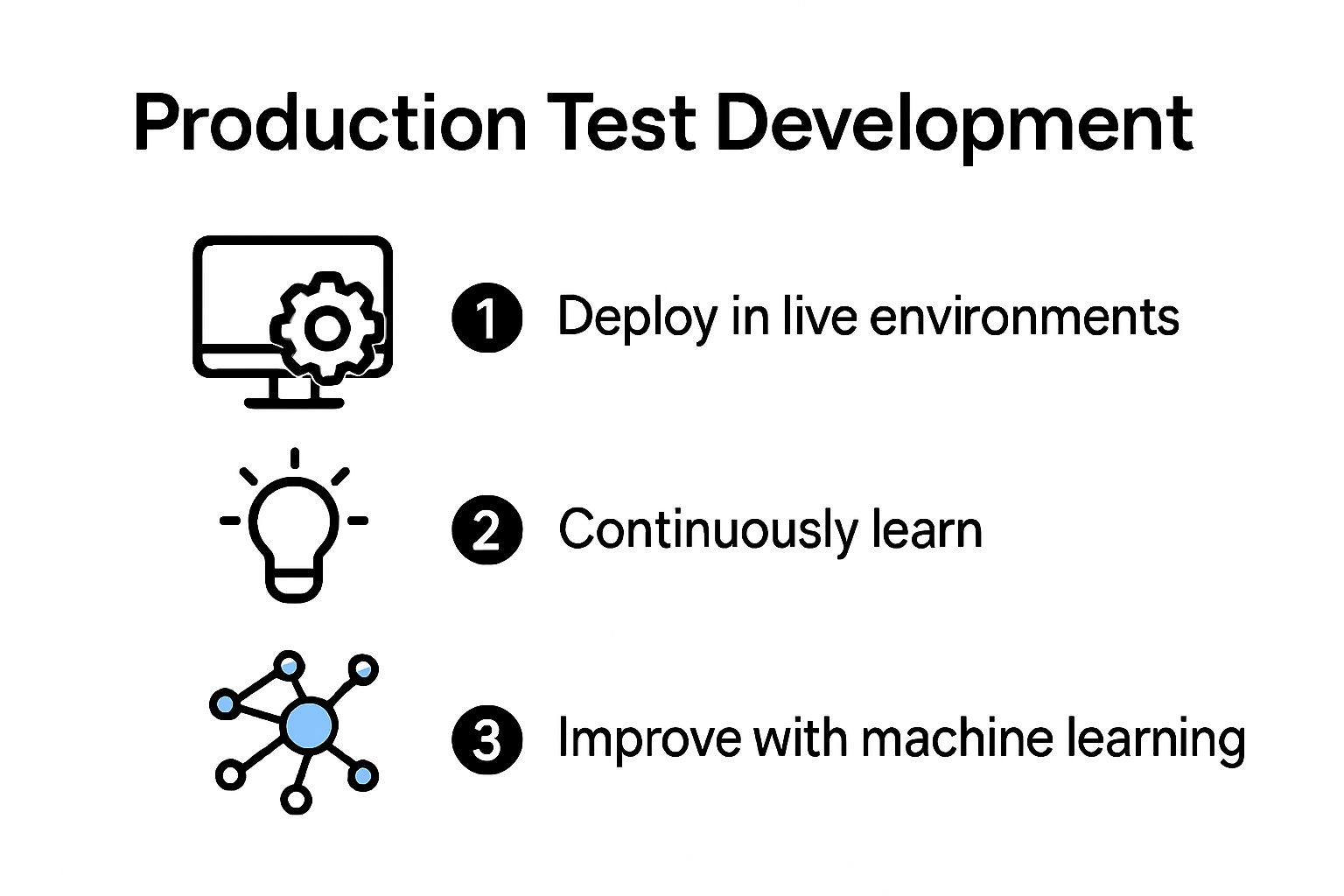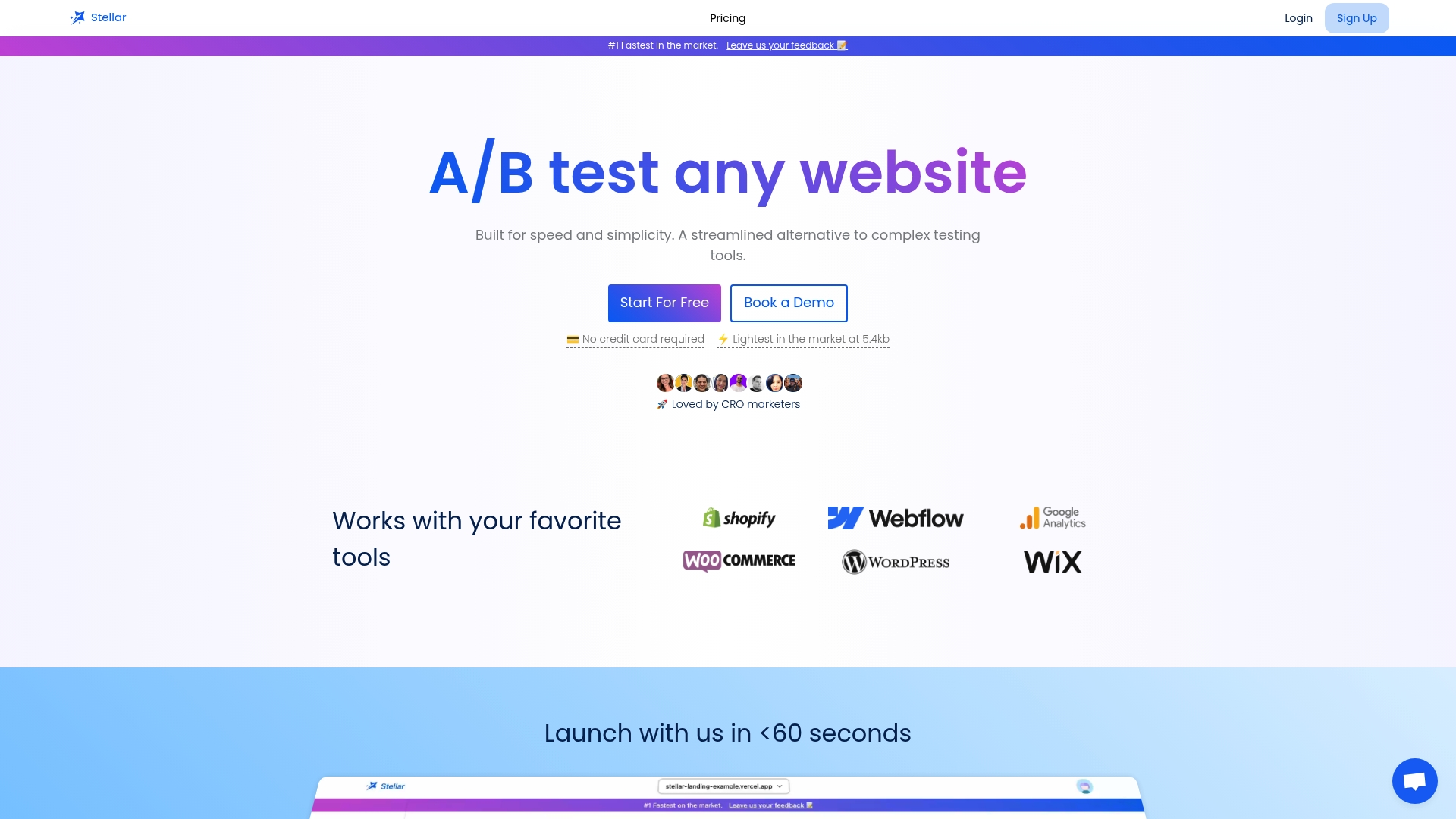
Production Test Development Strategies for CRO and Growth in 2025

Production test development is changing how CRO teams operate for 2025. Teams that integrate testing directly into live product environments see real world insights with minimal risk—far more than traditional A/B setups. Surprisingly, it is not the sheer scale of these tests that matters most. The twist is that the biggest leaps come from the ability to adapt and learn continuously, making even small experiments drive impressive growth when powered by advanced machine learning and rapid feedback.
Table of Contents
- Understanding Production Test Development For CRO Teams
- Best Practices For Testing In Live Environments
- Minimizing Risks And Maximizing Insights
- Scaling Production Test Development For Ecommerce Growth
Quick Summary
| Takeaway | Explanation |
|---|---|
| Integration of Testing into Product Development | Production test development embeds experimentation directly into live product environments, allowing for real-world insights with minimal risk. |
| Cross-Functional Collaboration | Successful implementation requires collaboration across product management, engineering, design, and marketing for effective experimental protocols and monitoring systems. |
| Dynamic Risk Management | Employing techniques like progressive exposure testing and real-time anomaly detection helps minimize performance risks during live testing. |
| Adaptive Learning Systems | Continuous experimentation and machine learning capabilities enable organizations to dynamically adjust tests based on real-time performance data, enhancing growth potential. |
| Ethical Frameworks and User Experience | Prioritizing ethical considerations ensures user consent, minimal impact, and strong data privacy protections, balancing technical capabilities with user-centric principles. |

Understanding Production Test Development for CRO Teams
Production test development represents a critical strategic approach for conversion rate optimization (CRO) teams seeking to drive meaningful growth and performance improvements. This comprehensive methodology goes beyond traditional testing frameworks by embedding experimentation directly into the product development lifecycle.
The Strategic Framework of Production Testing
Production test development emerges as a sophisticated approach that transforms how CRO teams conceptualize and execute optimization strategies. Unlike traditional A/B testing methods that operate in isolated environments, production testing integrates experimentation directly into live product environments. This approach allows teams to gather real world insights with minimal risk and maximum operational efficiency.
The core philosophy behind production test development centers on continuous learning and incremental improvement. Teams leverage advanced statistical models and robust testing protocols to validate hypotheses under actual user interaction conditions. By doing so, they can make data driven decisions that directly impact user experience and conversion metrics.
Key Components of Effective Production Test Development
Successful production test development requires a multifaceted approach that combines technical expertise, strategic thinking, and sophisticated analytical capabilities. CRO teams must focus on several critical elements to establish a robust testing framework:
- Experimental Design Crafting precise test scenarios that isolate specific variables and provide statistically significant results.
- Technical Infrastructure Building scalable testing environments that can handle complex experimental conditions without compromising system performance.
- Risk Mitigation Implementing safeguards that prevent negative user experiences during live testing scenarios.

Advanced production test development strategies also incorporate machine learning algorithms that can predict potential outcomes and optimize test parameters in real time. This dynamic approach allows teams to adapt quickly and minimize potential negative impacts on user experience.
Implementation Strategies for Modern CRO Teams
Implementing production test development requires a holistic approach that transcends traditional testing methodologies. CRO teams must develop cross functional collaboration models that integrate insights from product management, engineering, design, and marketing disciplines.
Key implementation strategies include:
- Establishing clear experimental protocols
- Creating robust monitoring systems
- Developing rapid iteration capabilities
- Building comprehensive reporting mechanisms
Teams that successfully implement production test development can expect significant performance improvements. Learn more about advanced testing solutions that can transform your optimization approach.
The future of CRO lies in sophisticated, data driven experimentation that balances technical complexity with user centric design. Production test development represents the cutting edge of this evolutionary process, enabling teams to unlock unprecedented insights and drive meaningful business growth.
Best Practices for Testing in Live Environments
Testing in live environments represents a sophisticated yet challenging approach for CRO teams seeking to extract maximum insights while minimizing potential user experience disruptions. The ability to conduct precise experiments within actual production settings requires a strategic blend of technical expertise, rigorous methodology, and nuanced risk management.
Minimizing Performance and User Experience Risks
Successful live environment testing hinges on implementing comprehensive safeguards that protect user experience while gathering critical performance data. CRO teams must develop multilayered strategies that balance experimental objectives with operational stability. This involves creating granular control mechanisms that can instantly halt or roll back tests if unexpected negative outcomes emerge.
Key risk mitigation techniques include progressive exposure testing, where experiments are initially rolled out to minimal user segments before broader implementation. Teams can leverage statistical modeling to predict potential performance variations and set predefined safety thresholds. Explore performance optimization techniques that ensure your testing remains both insightful and user friendly.
Designing Robust Experimental Protocols
Designing effective live environment tests demands precision engineering and meticulous planning. CRO professionals must construct experimental frameworks that:
- Isolate Variables Create controlled conditions that allow clear attribution of performance changes
- Establish Statistical Significance Implement sampling methods that provide mathematically valid insights
- Define Clear Measurement Parameters Develop comprehensive metrics that capture nuanced user interaction data
Advanced testing methodologies incorporate machine learning algorithms that can dynamically adjust experimental parameters in real time. These intelligent systems enable teams to optimize test configurations continuously, reducing manual intervention and increasing experimental efficiency.
Technical Infrastructure and Monitoring Strategies
The technical foundation supporting live environment testing is crucial for generating reliable insights. CRO teams must invest in robust monitoring infrastructure that provides instantaneous feedback and comprehensive performance tracking. This requires developing sophisticated observability systems capable of capturing granular user interaction data while maintaining minimal performance overhead.
Effective monitoring strategies involve:
- Real time performance tracking
- Automated anomaly detection
- Rapid rollback capabilities
- Comprehensive logging mechanisms
Successful implementation demands close collaboration between data scientists, engineering teams, and marketing professionals. By creating cross functional protocols, organizations can develop testing approaches that balance technical complexity with actionable business insights.
The future of CRO lies in creating adaptive testing ecosystems that can quickly respond to emerging user behaviors. Live environment testing represents a powerful methodology for teams committed to continuous optimization and data driven decision making. By embracing sophisticated experimental techniques, organizations can unlock unprecedented opportunities for growth and user experience enhancement.
Minimizing Risks and Maximizing Insights
Production test development demands a strategic approach to balancing experimental potential with organizational risk management. Successful CRO teams must develop sophisticated methodologies that extract maximum value while maintaining rigorous safety protocols and operational integrity.
Statistical Validation and Confidence Intervals
Robust risk mitigation begins with advanced statistical frameworks that provide mathematically sound validation mechanisms. CRO professionals must implement comprehensive confidence interval analysis that goes beyond traditional significance testing. This approach involves creating multidimensional statistical models that can predict potential experimental outcomes with high precision.
Key statistical validation techniques include:
- Bayesian Probability Modeling Utilizing probabilistic frameworks that account for multiple potential scenarios
- Sequential Testing Protocols Developing adaptive methodologies that can dynamically adjust experimental parameters
- Comprehensive Uncertainty Quantification Creating models that accurately represent potential variation ranges
By leveraging these advanced statistical approaches, teams can develop more nuanced understanding of experimental risks and potential performance variations. Learn about advanced testing confidence techniques that minimize potential negative outcomes.
Risk Mitigation Technological Frameworks
Technological infrastructure plays a critical role in minimizing experimental risks. Modern CRO teams must develop sophisticated monitoring systems that provide real time insights and instantaneous intervention capabilities. This requires building multilayered detection mechanisms that can identify potential performance anomalies before they impact overall user experience.
Effective risk mitigation technologies include:
- Automated rollback systems
- Granular traffic segmentation tools
- Real time performance monitoring
- Predictive anomaly detection algorithms
The most advanced risk management approaches incorporate machine learning algorithms that can predict potential experimental outcomes with increasing accuracy. These intelligent systems analyze historical performance data to generate predictive models that help teams make more informed decisions.
Ethical Considerations and User Experience Protection
Beyond technical considerations, production test development must prioritize ethical experimental practices and user experience protection. This involves developing comprehensive governance frameworks that establish clear boundaries for experimental interventions.
Key ethical considerations include:
- Transparent user consent mechanisms
- Minimal performance impact guarantees
- Clear experimental objective definitions
- Comprehensive data privacy protections
Successful risk management requires a holistic approach that balances technical capabilities with user centric design principles. Organizations must create experimental ecosystems that respect user expectations while driving meaningful performance improvements.
The future of production test development lies in creating adaptive experimental frameworks that can rapidly respond to emerging technological and user behavior trends. By developing sophisticated risk management strategies, CRO teams can transform experimental uncertainty into a powerful competitive advantage.
Scaling Production Test Development for Ecommerce Growth
Scaling production test development for ecommerce requires a strategic approach that balances technological sophistication with precise performance optimization. Successful ecommerce teams must develop comprehensive testing frameworks that can rapidly adapt to dynamic market conditions and evolving consumer behaviors.
Architectural Foundations for Scalable Testing
Building scalable production test development architectures demands robust technological infrastructure that can handle complex experimental scenarios without compromising site performance. Ecommerce organizations must create flexible testing environments that enable rapid experimentation across multiple user touchpoints while maintaining minimal performance overhead.
Key architectural considerations include:
- Modular Test Design Creating independent testing modules that can be quickly deployed and modified
- Microservices Integration Developing lightweight testing frameworks that integrate seamlessly with existing technological ecosystems
- Performance Optimization Ensuring testing infrastructure generates minimal latency impact
Advanced ecommerce teams leverage containerization and serverless computing technologies to create highly adaptable testing environments. These approaches allow for unprecedented flexibility in experimental design and deployment.
Dynamic Segmentation and Personalization Strategies
Effective production test development in ecommerce requires sophisticated user segmentation techniques that go beyond traditional demographic categorizations. Modern approaches incorporate machine learning algorithms to create dynamic user profiles that enable highly personalized experimental interventions.
Successful segmentation strategies involve:
- Behavioral pattern recognition
- Real time user journey mapping
- Predictive intent modeling
- Contextual experience optimization
Discover advanced conversion optimization techniques that can transform how you approach user segmentation and experimental design.
Continuous Experimentation and Adaptive Learning
The future of ecommerce production test development lies in creating adaptive learning ecosystems that can automatically adjust experimental parameters based on emerging performance data. This requires developing intelligent testing frameworks that incorporate continuous feedback loops and machine learning capabilities.
Key adaptive learning components include:
- Automated hypothesis generation
- Dynamic experimental parameter adjustment
- Predictive performance modeling
- Real time insight extraction
Organizations that successfully implement these advanced testing methodologies can create competitive advantages that extend far beyond traditional optimization approaches. By transforming experimental processes into intelligent, self evolving systems, ecommerce teams can unlock unprecedented growth potential.
Ultimately, scaling production test development is about creating a holistic approach that balances technological innovation with strategic business objectives. Teams that embrace sophisticated testing methodologies will be best positioned to navigate the complex and rapidly evolving ecommerce landscape of 2025 and beyond.
Frequently Asked Questions
What is production test development in CRO?
Production test development in CRO involves integrating experimentation directly into live product environments to gather real-world insights with minimal risk. This approach allows teams to make data-driven decisions that directly enhance user experience and conversion rates.
How does production testing differ from traditional A/B testing?
Unlike traditional A/B testing, which operates in isolated environments, production testing is conducted in live settings. This allows for immediate feedback and continuous learning, making it possible to adapt experiments based on real-time performance data.
What are best practices for testing in live environments?
Best practices for testing in live environments include minimizing performance risks by using progressive exposure testing, designing robust experimental protocols, and establishing comprehensive monitoring strategies to track user interaction and performance metrics effectively.
How can I scale production test development for ecommerce growth?
To scale production test development for ecommerce growth, organizations should build scalable architectures, implement dynamic segmentation and personalization strategies, and create continuous experimentation frameworks that leverage machine learning for adaptive learning and optimization.
Ready to Make Live Testing Your Fastest Growth Strategy?
Feeling pressured to turn live experimentation into real-world results, but worried about site speed or technical hurdles? This article highlights how production test development relies on rapid, risk-managed experimentation and actionable insights. Many marketers struggle with the complexity of traditional CRO tools, slow scripts, and the challenge of running robust live tests without harming user experience or relying on a dev team for every change.

You deserve a testing platform that removes those barriers right now. Stellar empowers growth teams with a no-code visual editor, lightning-fast script, and real-time analytics. Launch and optimize live product experiments at scale without impacting performance. Explore how fast and easy testing can truly be. Visit Stellar's homepage and see the difference for yourself. Get started today and turn every test into a growth opportunity.
Recommended Articles
Published: 6/20/2025